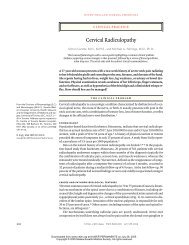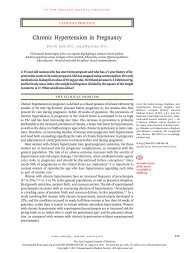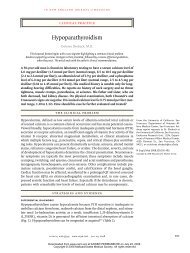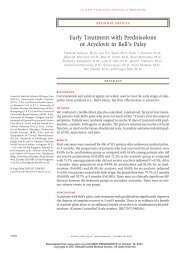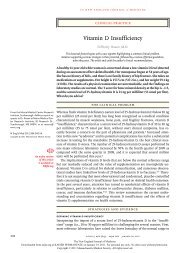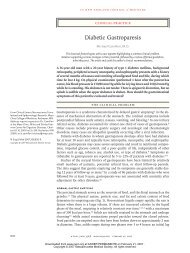Drug-Induced Immune Thrombocytopenia - Q-Notes for Adult Medicine
Drug-Induced Immune Thrombocytopenia - Q-Notes for Adult Medicine
Drug-Induced Immune Thrombocytopenia - Q-Notes for Adult Medicine
Create successful ePaper yourself
Turn your PDF publications into a flip-book with our unique Google optimized e-Paper software.
T h e n e w e ng l a nd j o u r na l o f m e dic i n e<br />
review article<br />
current concepts<br />
<strong>Drug</strong>-<strong>Induced</strong> <strong>Immune</strong> <strong>Thrombocytopenia</strong><br />
Richard H. Aster, M.D., and Daniel W. Bougie, Ph.D.<br />
From the Department of <strong>Medicine</strong>, Medical<br />
College of Wisconsin (R.H.A.), and the<br />
Blood Research Institute, BloodCenter of<br />
Wisconsin (R.H.A., D.W.B.) — both in<br />
Milwaukee. Address reprint requests to<br />
Dr. Aster at the Blood Research Institute,<br />
BloodCenter of Wisconsin, 8727 Watertown<br />
Plank Rd., Milwaukee, WI 53226-3548,<br />
or at richard.aster@bcw.edu.<br />
N Engl J Med 2007;357:580-7.<br />
Copyright © 2007 Massachusetts Medical Society.<br />
<strong>Drug</strong>-induced thrombocytopenia can be caused by dozens, perhaps<br />
hundreds, of medications. Because thrombocytopenia can have many<br />
other causes, the diagnosis of drug-induced thrombocytopenia can easily<br />
be overlooked. On occasion, outpatients with drug-induced thrombocytopenia are<br />
treated <strong>for</strong> autoimmune thrombocytopenia and can have two or three recurrences<br />
be<strong>for</strong>e the drug causing the disorder is identified. 1 In acutely ill, hospitalized patients,<br />
drug-induced thrombocytopenia can be overlooked because thrombocytopenia<br />
is attributed to sepsis, the effect of coronary-artery bypass surgery, or some other<br />
underlying condition. Although drug-induced thrombocytopenia is uncommon, it can<br />
have devastating, even fatal consequences that can usually be prevented simply by<br />
discontinuing the causative drug. It is there<strong>for</strong>e important that clinicians have a<br />
general understanding of this condition and the drugs that can cause it.<br />
In this review, we focus on conditions in which exposure to a drug leads to the<br />
destruction of circulating platelets, often accompanied by bleeding symptoms. We<br />
do not consider thrombocytopenia resulting from dose-dependent hematosuppression,<br />
which often occurs after treatment with chemotherapeutic and immunosuppressive<br />
agents such as cisplatin and cyclophosphamide. 2 Although heparin-induced<br />
thrombocytopenia is the most common drug-related cause of a drop in the platelet<br />
count, we do not discuss this condition because of its complexity and because<br />
thrombosis, rather than thrombocytopenia, is the major threat to an affected patient.<br />
Because heparin is often given together with certain drugs that are likely to<br />
cause drug-induced thrombocytopenia (platelet inhibitors and vancomycin), it is<br />
important to distinguish between heparin-induced thrombocytopenia and druginduced<br />
thrombocytopenia. Heparin-induced thrombocytopenia was recently reviewed<br />
in the Journal. 3<br />
<strong>Drug</strong>-induced platelet destruction is usually caused by drug-induced antibodies,<br />
but this can be difficult to prove. In this review, we include many conditions <strong>for</strong><br />
which an immune cause has not yet been fully documented. Although platelets are<br />
the preferred targets of drug-induced antibodies, drugs can also cause immune<br />
hemolytic anemia 4 and neutropenia 5 through similar mechanisms.<br />
Pr esen tation<br />
Acute thrombocytopenia after exposure to quinine was recognized as a clinical<br />
entity about 140 years ago. 6 Subsequently, many other medications were implicated<br />
in the development of this condition. Quinine, which is rarely used now as an antimalarial<br />
drug but is often prescribed <strong>for</strong> nocturnal muscle cramps, may still be the<br />
most common trigger. People of any age and either sex can be affected.<br />
The course of drug-induced thrombocytopenia in a representative patient is<br />
shown in Figure 1. Typically, a patient will have taken the sensitizing drug <strong>for</strong><br />
about 1 week or intermittently over a longer period be<strong>for</strong>e presenting with petechial<br />
580<br />
n engl j med 357;6 www.nejm.org august 9, 2007<br />
Downloaded from www.nejm.org at KAISER PERMANENTE on August 14, 2007 .<br />
Copyright © 2007 Massachusetts Medical Society. All rights reserved.
current concepts<br />
hemorrhages and ecchymoses that are indicative<br />
of thrombocytopenia. Occasionally, symptoms develop<br />
within 1 or 2 days after what is apparently<br />
the first exposure to a drug, particularly in patients<br />
given platelet inhibitors such as abciximab<br />
who may have preexisting, perhaps naturally occurring,<br />
antibodies. 7 Systemic symptoms such as<br />
lightheadedness, chills, fever, nausea, and vomiting<br />
often precede bleeding symptoms. Severely<br />
affected patients have florid purpura and bleeding<br />
from the nose, gums, and gastrointestinal<br />
or urinary tract (“wet purpura”). In such cases,<br />
thrombocytopenia is invariably severe (
T h e n e w e ng l a nd j o u r na l o f m e dic i n e<br />
Table 1. <strong>Drug</strong>s Commonly Implicated as Triggers of <strong>Drug</strong>-<strong>Induced</strong> <strong>Thrombocytopenia</strong>.*<br />
<strong>Drug</strong> Category <strong>Drug</strong>s Implicated in Five or More Reports Other <strong>Drug</strong>s<br />
Heparins<br />
Cinchona alkaloids<br />
Platelet inhibitors<br />
Unfractionated heparin, low-molecular-weight heparin<br />
Quinine, quinidine<br />
Abciximab, eptifibatide, tirofiban<br />
Antirheumatic agents Gold salts D-penicillamine<br />
Antimicrobial agents<br />
Linezolid, rifampin, sulfonamides, vancomycin<br />
Sedatives and anticonvulsant agents Carbamazepine, phenytoin, valproic acid Diazepam<br />
Histamine-receptor antagonists Cimetidine Ranitidine<br />
Analgesic agents Acetaminophen, diclofenac, naproxen Ibuprofen<br />
Diuretic agents Chlorothiazide Hydrochlorothiazide<br />
Chemotherapeutic and immunosuppressant<br />
agents<br />
Fludarabine, oxaliplatin<br />
Cyclosporine, rituximab<br />
* For a more extensive list, see Aster, 2 Warkentin, 12 and George et al. 13 and the University of Oklahoma Web site (http://<br />
moon.ouhsc.edu/jgeorge/DITP.html).<br />
Table 2. Criteria and Level of Evidence <strong>for</strong> Establishing a Causative Relationship in <strong>Drug</strong>-<strong>Induced</strong> Thrombocytopenic<br />
Purpura.*<br />
Criterion and Level of Evidence<br />
Criterion<br />
Description<br />
1 Therapy with the candidate drug preceded thrombocytopenia, and recovery from<br />
thrombocytopenia was complete and sustained after discontinuation of therapy.<br />
2 The candidate drug was the only drug used be<strong>for</strong>e the onset of thrombocytopenia,<br />
or other drugs were continued or reintroduced after discontinuation of therapy<br />
with the candidate drug, with a sustained normal platelet count.<br />
3 Other causes of thrombocytopenia were ruled out.<br />
4 Re-exposure to the candidate drug resulted in recurrent thrombocytopenia.<br />
Level of evidence<br />
I<br />
II<br />
III<br />
IV<br />
* The in<strong>for</strong>mation is adapted from George et al. 13<br />
Definite — criteria 1, 2, 3, and 4 are met.<br />
Probable — criteria 1, 2, and 3 are met.<br />
Possible — criterion 1 is met.<br />
Unlikely — criterion 1 is not met.<br />
penia after injection of iodinated contrast medium<br />
<strong>for</strong> radiographic studies. 12,13 Whether immune<br />
mechanisms are involved is unknown.<br />
Severe thrombocytopenia and other signs and<br />
symptoms of thrombotic thrombocytopenic purpura<br />
develop in approximately 1 of every 2500<br />
patients treated with the platelet inhibitor ticlopidine<br />
and a much smaller fraction of those given<br />
the closely related drug clopidogrel, usually after<br />
1 to 2 weeks of treatment. 19 The responsible<br />
mechanisms have not yet been defined. Acute,<br />
severe, usually self-limited thrombocytopenia has<br />
been described in patients treated with recently<br />
developed monoclonal antibodies such as infliximab<br />
(anti–tumor necrosis factor-α antibody),<br />
efalizumab (anti-CD11a antibody), and rituximab<br />
(anti-CD20 antibody). 2 No causative mechanism<br />
has yet been identified.<br />
Certain drugs, such as the antiepileptic agent<br />
valproate, 20 the cardiac agent amrinone, 21 and the<br />
antibiotic linezolid, 22 induce low-grade thrombocytopenia<br />
in up to 30% of patients receiving long-<br />
582<br />
n engl j med 357;6 www.nejm.org august 9, 2007<br />
Downloaded from www.nejm.org at KAISER PERMANENTE on August 14, 2007 .<br />
Copyright © 2007 Massachusetts Medical Society. All rights reserved.
current concepts<br />
term treatment; the mechanisms of action may<br />
be nonimmune but are poorly understood. The<br />
decrease in platelets is rarely severe enough to<br />
require treatment.<br />
Although chemotherapeutic and immunosuppressive<br />
agents typically cause thrombocytopenia<br />
by suppressing hematopoiesis, they can also<br />
cause immune thrombocytopenia. 23 <strong>Drug</strong>-induced<br />
thrombocytopenia should be suspected, there<strong>for</strong>e,<br />
in patients treated with such drugs if there is an<br />
acute drop in the platelet level after exposure.<br />
<strong>Immune</strong> thrombocytopenia caused by vancomycin<br />
is probably more common than is generally<br />
recognized, and it is easily overlooked in seriously<br />
ill patients because the low platelet count can<br />
be attributed to other causes. 24 In rare cases, the<br />
quinine in tonic water or an aperitif causes immune<br />
thrombocytopenia (“cocktail purpura”). 25<br />
Patho genesis<br />
<strong>Drug</strong>-induced thrombocytopenia, like other idiosyncratic<br />
drug-sensitivity reactions, affects only<br />
a small fraction of patients taking medications<br />
that can trigger the disorder. No predisposing<br />
genetic or environmental factors have been identified,<br />
and no suitable animal models are available.<br />
Mechanisms by which drugs are thought to<br />
cause immune thrombocytopenia are summarized<br />
in Table 3.<br />
<strong>Thrombocytopenia</strong> <strong>Induced</strong> by Quinine<br />
and Other <strong>Drug</strong>s<br />
The hallmark of thrombocytopenia induced by<br />
quinine and many other drugs is a remarkable<br />
antibody that binds tightly to normal platelets<br />
only in the presence of the sensitizing drug. The<br />
epitopes targeted by these antibodies usually reside<br />
on glycoprotein IIb/IIIa or Ib/V/IX complexes,<br />
the major platelet receptors <strong>for</strong> fibrinogen and<br />
von Willebrand factor, respectively. 26,27<br />
Small molecules, like drugs, are thought to be<br />
immunogenic only when linked covalently to a<br />
large carrier molecule, usually a protein. Antibodies<br />
induced by drug–protein adducts are largely<br />
specific <strong>for</strong> the drug (or the small molecule, called<br />
the hapten), although some antibodies recognize<br />
the drug and its carrier molecule. 28 Accordingly,<br />
early investigators assumed that drug-dependent<br />
antibodies found in patients with drug-induced<br />
thrombocytopenia were hapten-specific (or drugspecific).<br />
This may be true of antibodies that<br />
cause hemolytic anemia in patients treated with<br />
massive doses of penicillin 29 and perhaps some<br />
of those that cause thrombocytopenia in patients<br />
given penicillin-like drugs. 30 However, serologic<br />
studies in patients with drug-induced thrombocytopenia<br />
caused by other drugs failed to support<br />
this concept. 31 An alternative hypothesis was<br />
that the drug reacts directly with the antibody to<br />
produce immune complexes that somehow target<br />
Table 3. Mechanisms Underlying <strong>Drug</strong>-<strong>Induced</strong> <strong>Immune</strong> <strong>Thrombocytopenia</strong>.*<br />
Classification Mechanism Incidence Examples of <strong>Drug</strong>s<br />
Hapten-dependent Hapten links covalently to membrane protein Very rare<br />
Penicillin, possibly some cephalosporin<br />
antibody and induces drug-specific immune response<br />
antibiotics<br />
Quinine-type drug<br />
Fiban-type drug<br />
<strong>Drug</strong>-specific<br />
antibody<br />
Autoantibody<br />
<strong>Immune</strong> complex<br />
* The in<strong>for</strong>mation is adapted from Aster. 2<br />
<strong>Drug</strong> induces antibody that binds to membrane<br />
protein in presence of soluble drug<br />
<strong>Drug</strong> reacts with glycoprotein IIb/IIIa to induce<br />
a con<strong>for</strong>mational change (neoepitope) recognized<br />
by antibody (not yet confirmed)<br />
Antibody recognizes murine component of<br />
chimeric Fab fragment specific <strong>for</strong> platelet<br />
membrane glycoprotein IIIa<br />
<strong>Drug</strong> induces antibody that reacts with autologous<br />
platelets in absence of drug<br />
<strong>Drug</strong> binds to platelet factor 4, producing immune<br />
complex <strong>for</strong> which antibody is specific;<br />
immune complex activates platelets through<br />
Fc receptors<br />
26 cases per 1 million users of<br />
quinine per week, probably<br />
fewer cases with other drugs<br />
Quinine, sulfonamide antibiotics,<br />
nonsteroidal antiinflammatory<br />
drugs<br />
0.2–0.5% Tirofiban, eptifibatide<br />
0.5–1.0% after first exposure,<br />
10–14% after second exposure<br />
Abciximab<br />
1.0% with gold, very rare with procainamide<br />
and other drugs<br />
Gold salts, procainamide<br />
3–6% among patients treated with Heparins<br />
unfractionated heparin <strong>for</strong> 7 days,<br />
rare with low-molecular-weight<br />
heparin<br />
n engl j med 357;6 www.nejm.org august 9, 2007 583<br />
Downloaded from www.nejm.org at KAISER PERMANENTE on August 14, 2007 .<br />
Copyright © 2007 Massachusetts Medical Society. All rights reserved.
T h e n e w e ng l a nd j o u r na l o f m e dic i n e<br />
platelets and cause their destruction. 31 However,<br />
these hypothetical drug–antibody complexes were<br />
never demonstrated experimentally, and it was<br />
later found that drug-dependent antibodies, like<br />
other antibodies, react with platelets through<br />
their Fab domains rather than through their Fc<br />
domains, as would be expected of immune complexes.<br />
32,33 Other possibilities considered were<br />
that the drug reacts with the target protein to<br />
produce a compound epitope (part drug, part protein)<br />
<strong>for</strong> which the antibody is specific 34,35 and<br />
that the drug induces a con<strong>for</strong>mational change<br />
in the protein, creating a new target epitope elsewhere<br />
in the molecule. 2,36<br />
A recently proposed model aimed at reconciling<br />
several of these hypotheses 37 suggests that<br />
drug-dependent antibodies are derived from a<br />
pool of naturally occurring antibodies with weak<br />
affinity <strong>for</strong> self antigens, 38 residing in this case<br />
on certain platelet membrane glycoproteins. According<br />
to this model, the interaction between<br />
these low-affinity antibodies and their target<br />
antigens is too weak to affect blood cells under<br />
normal circumstances. However, certain drugs<br />
affect both antibody and antigen in such a way<br />
that the strength of the interaction is greatly increased<br />
(Fig. 2). When a B cell expressing such<br />
an antibody is induced to proliferate and undergo<br />
affinity maturation in a patient taking the medication,<br />
the resulting antibody can destroy the<br />
targeted blood cell if the drug is present. 37 This<br />
model suggests that whether the drug binds first<br />
to the antibody or to the targeted membrane protein<br />
depends simply on its relative affinity <strong>for</strong><br />
one component or the other.<br />
<strong>Thrombocytopenia</strong> <strong>Induced</strong> by Platelet<br />
Inhibitors<br />
Acute thrombocytopenia, usually mild but occasionally<br />
life-threatening, is a common complication<br />
of treatment with the platelet inhibitors tirofiban<br />
and eptifibatide, which are widely used to<br />
prevent restenosis after coronary angioplasty. 7<br />
These ligand-mimetic drugs (“fibans”) inhibit<br />
thrombosis by binding to a specific site on the<br />
platelet α IIb<br />
/β 3 integrin (glycoprotein IIb/IIIa) and<br />
competitively inhibiting platelet–fibrinogen interaction.<br />
7 Antibodies causing thrombocytopenia in<br />
patients given these agents probably recognize<br />
structural changes (neoepitopes) induced in the<br />
α IIb<br />
/β 3 integrin when a fiban binds to it, but this<br />
theory has not been <strong>for</strong>mally proved. Curiously,<br />
these antibodies can occur naturally, creating the<br />
possibility that thrombocytopenia will arise within<br />
a few hours after the patient’s first exposure to<br />
the drug. 7<br />
<strong>Thrombocytopenia</strong> <strong>Induced</strong> by Abciximab<br />
Abciximab is a widely used chimeric (human–<br />
mouse) Fab fragment that is specific <strong>for</strong> β3 integrin<br />
(glycoprotein IIIa). Like the fibans, it blocks<br />
platelet–fibrinogen interaction. Abciximab itself<br />
does not cause thrombocytopenia because it lacks<br />
the Fc domain required <strong>for</strong> recognition of antibody-coated<br />
platelets by phagocytes. However, in<br />
about 1% of patients given abciximab <strong>for</strong> the<br />
first time, and in more than 10% of those treated<br />
a second time, acute thrombocytopenia develops<br />
within a few hours of starting an infusion. 39 In<br />
some patients the onset of thrombocytopenia is<br />
delayed until 5 to 8 days after the initial 24- to<br />
48-hour period of exposure to the drug. 40 Abciximab-induced<br />
thrombocytopenia is often mild, but<br />
fatalities have been recorded. 41,42<br />
Acute thrombocytopenia after first exposure<br />
to abciximab appears to be caused by preexisting<br />
antibodies specific <strong>for</strong> murine structural elements<br />
in the abciximab molecule. 40,42 Antibodies that<br />
cause delayed thrombocytopenia are newly induced<br />
but recognize the same target; they cause thrombocytopenia<br />
because abciximab-coated platelets<br />
are still present in the circulation 10 to 14 days<br />
after treatment. 40<br />
<strong>Thrombocytopenia</strong> Due to <strong>Drug</strong>-<strong>Induced</strong><br />
Autoantibodies<br />
In rare cases, drugs induce true autoantibodies<br />
that are capable of destroying platelets in the absence<br />
of the sensitizing agent. 43 About 1% of patients<br />
treated with gold salts <strong>for</strong> rheumatoid arthritis<br />
have this complication. 44 Autoantibodies<br />
induced by gold may be unique in having specificity<br />
<strong>for</strong> platelet membrane glycoprotein V. 45 Other<br />
drugs that are probably capable of inducing autoimmune<br />
thrombocytopenia include procainamide,<br />
sulfonamide antibiotics, and interferons alfa and<br />
beta. 2,12,13,43 Acute, sometimes severe, but usually<br />
transient thrombocytopenia can occur several<br />
weeks after the vaccination of children or adults<br />
<strong>for</strong> various infectious diseases, but it is rare. 46,47<br />
This condition resembles acute idiopathic thrombocytopena,<br />
which sometimes develops in children<br />
after a viral infection, but its cause has not<br />
been established.<br />
584<br />
n engl j med 357;6 www.nejm.org august 9, 2007<br />
Downloaded from www.nejm.org at KAISER PERMANENTE on August 14, 2007 .<br />
Copyright © 2007 Massachusetts Medical Society. All rights reserved.
current concepts<br />
H<br />
<strong>Drug</strong>-dependent<br />
antibody CDR<br />
+<br />
<strong>Drug</strong><br />
H<br />
+<br />
H<br />
<strong>Drug</strong>-dependent<br />
antibody CDR<br />
+<br />
+<br />
+<br />
+<br />
Platelet antigen<br />
Low-affinity fit<br />
Platelet antigen<br />
High-affinity fit<br />
Figure 2. Model <strong>for</strong> the Binding of a <strong>Drug</strong>-Dependent Antibody to an Epitope on a Platelet Glycoprotein.<br />
COLOR FIGURE<br />
Antibodies capable of causing drug-dependent thrombocytopenia react weakly with an epitope on a target glycoprotein. The binding affinity<br />
Draft 5 06/15/07<br />
(K A ) <strong>for</strong> this interaction is too low to allow a sufficient number of antibody molecules to bind in the absence of the drug (“low-affinity<br />
Author Aster<br />
fit”). The drug contains structural elements that are complementary to a negatively charged site on the glycoprotein<br />
Fig #<br />
and a hydrophobic<br />
2<br />
site (H) on the complementarity-determining region (CDR) of the antibody. The drug interacts with these sites to Title improve <strong>Drug</strong>-dependent the fit between<br />
antibody binding<br />
the two proteins, increasing the K A to a value that permits binding to occur at levels of antibody, antigen, and ME drug achieved in the circulation<br />
after ingestion of the drug (“high-affinity fit”). Adapted from Bougie et al. 37<br />
DE<br />
Artist<br />
Campion<br />
KMK<br />
AUTHOR PLEASE NOTE:<br />
Figure has been redrawn and type has been reset<br />
Please check carefully<br />
Platelet-specific autoimmunity induced by drugs<br />
is clinically similar to acute idiopathic autoimmune<br />
thrombocytopenia. 43 The possibility that<br />
drug-induced autoimmune thrombocytopenia is<br />
not uncommon remains speculative.<br />
Di agnosis<br />
<strong>Drug</strong>-induced thrombocytopenia should be suspected<br />
in any patient who presents with acute<br />
thrombocytopenia of unknown cause. In considering<br />
this diagnosis, the clinician should keep in<br />
mind that 5 to 7 days of exposure is usually needed<br />
to produce sensitization in a patient given a<br />
drug <strong>for</strong> the first time. As previously noted, platelet<br />
inhibitors are exceptions to this general rule.<br />
In adults, the presence of severe thrombocytopenia<br />
(
T h e n e w e ng l a nd j o u r na l o f m e dic i n e<br />
tial drop in platelet levels, 51 and a conventional<br />
dose can cause severe thrombocytopenia and<br />
bleeding. 52 There<strong>for</strong>e, it is important to start with<br />
a few milligrams of the drug and to monitor<br />
platelet counts closely <strong>for</strong> 24 hours. Antibodies<br />
sometimes become undetectable after a few<br />
months, in which case the drug may initially<br />
have no effect on the platelet count.<br />
Tr e atmen t a nd Pro gnosis<br />
Many patients with drug-induced thrombocytopenia<br />
have only petechial hemorrhages and occasional<br />
ecchymoses and require no specific treatment<br />
other than discontinuation of the sensitizing<br />
medication. When there is uncertainty about the<br />
causative drug, all medications should be discontinued,<br />
and pharmacologic equivalents with different<br />
chemical structures substituted as necessary.<br />
Patients who have severe thrombocytopenia and<br />
“wet purpura” should be aggressively treated with<br />
platelet transfusions because of the risk of fatal<br />
intracranial or intrapulmonary hemorrhage. 2,53,54<br />
Corticosteroids are often given, but there is no<br />
evidence that they are helpful if the thrombocytopenia<br />
is drug-induced. Intravenous immune globulin<br />
55 and plasma exchange 56 have been used in<br />
acutely ill patients, but the benefit of these treatments<br />
is uncertain. 2<br />
Once established, drug sensitivity probably persists<br />
indefinitely. There<strong>for</strong>e, patients should be<br />
advised to avoid permanently the medication<br />
thought to be the cause of thrombocytopenia.<br />
Fortunately, drug-induced antibodies tend to be<br />
specific <strong>for</strong> the sensitizing drug, 57 and patients<br />
usually tolerate pharmacologic equivalents, even<br />
those with quite similar structures.<br />
Supported by grants from the National Heart, Lung, and Blood<br />
Institute (HL-13629 and HL-44612) and the Northland affiliate<br />
of the American Heart Association (0235419Z).<br />
No potential conflict of interest relevant to this article was<br />
reported.<br />
References<br />
1. Reddy JC, Shuman MA, Aster RH.<br />
Quinine/quinidine-induced thrombocytopenia:<br />
a great imitator. Arch Intern Med<br />
2004;164:218-20.<br />
2. Aster R. <strong>Drug</strong>-induced thrombocytopenia.<br />
In: Michelson AD, ed. Platelets.<br />
New York: Academic Press, 2007:887-902.<br />
3. Arepally GM, Ortel TL. Heparininduced<br />
thrombocytopenia. N Engl J Med<br />
2006;355:809-17.<br />
4. Arndt PA, Garratty G. The changing<br />
spectrum of drug-induced immune hemolytic<br />
anemia. Semin Hematol 2005;42:<br />
137-44.<br />
5. Stroncek DF. <strong>Drug</strong>-induced immune<br />
neutropenia. Transfus Med Rev 1993;7:268-<br />
74.<br />
6. Vipan W. Quinine as a cause of purpura.<br />
Lancet 1865;2:37.<br />
7. Aster RH. <strong>Immune</strong> thrombocytopenia<br />
caused by glycoprotein IIb/IIIa inhibitors.<br />
Chest 2005;127:Suppl 2:53S-59S.<br />
8. Knower MT, Bowton DL, Owen J, Dunagan<br />
DP. Quinine-induced disseminated<br />
intravascular coagulation: case report and<br />
review of the literature. Intensive Care Med<br />
2003;29:1007-11.<br />
9. Kojouri K, Vesely SK, George JN. Quinine-associated<br />
thrombotic thrombocytopenic<br />
purpura–hemolytic uremic syndrome:<br />
frequency, clinical features, and long-term<br />
outcomes. Ann Intern Med 2001;135:1047-<br />
51.<br />
10. van den Bemt PM, Meyboom RH, Egberts<br />
AC. <strong>Drug</strong>-induced immune thrombocytopenia.<br />
<strong>Drug</strong> Saf 2004;27:1243-52.<br />
11. Kaufman DW, Kelly JP, Johannes CB,<br />
et al. Acute thrombocytopenic purpura in<br />
relation to the use of drugs. Blood 1993;<br />
82:2714-8.<br />
12. Warkentin TE. <strong>Thrombocytopenia</strong> due<br />
to platelet destruction and hypersplenism.<br />
In: Hoffman R, Benz EJ Jr, Shattil SJ, et al.,<br />
eds. Hematology: basic principles and practice.<br />
4th ed. Philadelphia: Elsevier, 2005:<br />
2305-25.<br />
13. George JN, Raskob GE, Shah SR, et al.<br />
<strong>Drug</strong>-induced thrombocytopenia: a systematic<br />
review of published case reports.<br />
Ann Intern Med 1998;129:886-90.<br />
14. Roujeau JC, Kelly JP, Naldi L, et al.<br />
Medication use and the risk of Stevens–<br />
Johnson syndrome or toxic epidermal<br />
necrolysis. N Engl J Med 1995;333:1600-<br />
7.<br />
15. Li X, Hunt L, Vesely SK. <strong>Drug</strong>-induced<br />
thrombocytopenia: an updated systematic<br />
review. Ann Intern Med 2005;142:474-5.<br />
16. Arnold J, Ouwehand WH, Smith GA,<br />
Cohen H. A young woman with petechiae.<br />
Lancet 1998;352:618.<br />
17. Azuno Y, Yaga K, Sasayama T, Kimoto<br />
K. <strong>Thrombocytopenia</strong> induced by Jui, a traditional<br />
Chinese herbal medicine. Lancet<br />
1999;354:304-5.<br />
18. Lavy R. Thrombocytopenic purpura<br />
due to lupinus termis bean. J Allergy Clin<br />
Immunol 1964;35:386-9.<br />
19. Bennett CL, Connors JM, Carwile JM,<br />
et al. Thrombotic thrombocytopenic purpura<br />
associated with clopidogrel. N Engl J<br />
Med 2000;342:1773-7.<br />
20. Trannel TJ, Ahmed I, Goebert D. Occurrence<br />
of thrombocytopenia in psychi-<br />
atric patients taking valproate. Am J Psychiatry<br />
2001;158:128-30.<br />
21. Ross MP, Allen-Webb EM, Pappas JB,<br />
McGough EC. Amrinone-associated thrombocytopenia:<br />
pharmacokinetic analysis.<br />
Clin Pharmacol Ther 1993;53:661-7.<br />
22. Attassi K, Hershberger E, Alam R,<br />
Zervos MJ. <strong>Thrombocytopenia</strong> associated<br />
with linezolid therapy. Clin Infect Dis<br />
2002;34:695-8.<br />
23. Curtis BR, Kaliszewski J, Marques MB,<br />
et al. <strong>Immune</strong>-mediated thrombocytopenia<br />
resulting from sensitivity to oxaliplatin.<br />
Am J Hematol 2006;81:193-8.<br />
24. Von Drygalski A, Curtis BR, Bougie<br />
DW, et al. Vancomycin-induced immune<br />
thrombocytopenia. N Engl J Med 2007;<br />
356:904-10.<br />
25. Belkin GA. Cocktail purpura: an unusual<br />
case of quinine sensitivity. Ann Intern<br />
Med 1967;66:583-6.<br />
26. Visentin GP, Newman PJ, Aster RH.<br />
Characteristics of quinine- and quinidineinduced<br />
antibodies specific <strong>for</strong> platelet<br />
glycoproteins IIb and IIIa. Blood 1991;77:<br />
2668-76.<br />
27. Asvadi P, Ahmadi Z, Chong BH. <strong>Drug</strong>induced<br />
thrombocytopenia: localization of<br />
the binding site of GPIX-specific quininedependent<br />
antibodies. Blood 2003;102:<br />
1670-7.<br />
28. Parker CW. Hapten immunology and<br />
allergic reactions in humans. Arthritis<br />
Rheum 1981;24:1024-36.<br />
29. Garratty G. <strong>Immune</strong> cytopenia associated<br />
with antibiotics. Transfus Med Rev<br />
1993;7:255-67.<br />
586<br />
n engl j med 357;6 www.nejm.org august 9, 2007<br />
Downloaded from www.nejm.org at KAISER PERMANENTE on August 14, 2007 .<br />
Copyright © 2007 Massachusetts Medical Society. All rights reserved.
current concepts<br />
30. Salamon DJ, Nusbacher J, Stroupe T,<br />
Wilson JH, Hanrahan JB. Red cell and<br />
platelet-bound IgG penicillin antibodies<br />
in a patient with thrombocytopenia.<br />
Transfusion 1984;24:395-8.<br />
31. Shulman NR. A mechanism of cell<br />
destruction in individuals sensitized to<br />
<strong>for</strong>eign antigens and its implications in<br />
auto-immunity: combined Clinical Staff<br />
Conference at the National Institutes of<br />
Health. Ann Intern Med 1964;60:506-21.<br />
32. Christie DJ, Mullen PC, Aster RH.<br />
Fab-mediated binding of drug-dependent<br />
antibodies to platelets in quinidine- and<br />
quinine-induced thrombocytopenia. J Clin<br />
Invest 1985;75:310-4.<br />
33. Smith ME, Reid DM, Jones CE, Jordan<br />
JV, Kautz CA, Shulman NR. Binding of<br />
quinine- and quinidine-dependent drug<br />
antibodies to platelets is mediated by the<br />
Fab domain of the immunoglobulin G and<br />
is not Fc dependent. J Clin Invest 1987;79:<br />
912-7.<br />
34. Mueller-Eckhardt C, Salama A. <strong>Drug</strong>induced<br />
immune cytopenias: a unifying<br />
pathogenetic concept with special emphasis<br />
on the role of drug metabolites. Transfus<br />
Med Rev 1990;4:69-77.<br />
35. Shulman NR, Reid DM. Mechanisms<br />
of drug-induced immunologically mediated<br />
cytopenias. Transfus Med Rev 1993;7:<br />
215-29.<br />
36. Aster RH. <strong>Drug</strong>-induced immune cytopenias.<br />
Toxicology 2005;209:149-53.<br />
37. Bougie DW, Wilker PR, Aster RH.<br />
Patients with quinine-induced immune<br />
thrombocytopenia have both “drug-dependent”<br />
and “drug-specific” antibodies. Blood<br />
2006;108:922-7.<br />
38. Pillai S. Two lymphoid roads diverge<br />
— but does antigen bade B cells to take<br />
the road less traveled? Immunity 2005;23:<br />
242-4.<br />
39. Tcheng JE, Kereiakes DJ, Lincoff AM,<br />
et al. Abciximab readministration: results<br />
of the ReoPro Readministration Registry.<br />
Circulation 2001;104:870-5.<br />
40. Curtis BR, Divgi A, Garritty M, Aster<br />
RH. Delayed thrombocytopenia after treatment<br />
with abciximab: a distinct clinical<br />
entity associated with the immune response<br />
to the drug. J Thromb Haemost<br />
2004;2:985-92.<br />
41. McCorry RB, Johnston P. Fatal delayed<br />
thrombocytopenia following abciximab<br />
therapy. J Invasive Cardiol 2006;18:<br />
E173-E174.<br />
42. Curtis BR, Swyers J, Divgi A, McFarland<br />
JG, Aster RH. <strong>Thrombocytopenia</strong><br />
after second exposure to abciximab is<br />
caused by antibodies that recognize abciximab-coated<br />
platelets. Blood 2002;99:<br />
2054-9.<br />
43. Aster RH. Can drugs cause autoimmune<br />
thrombocytopenic purpura? Semin<br />
Hematol 2000;37:229-38.<br />
44. von dem Borne AE, Pegels JG, van der<br />
Stadt RJ, van der Plas-van Dalen CM, Helmerhorst<br />
FM. <strong>Thrombocytopenia</strong> associated<br />
with gold therapy: a drug-induced<br />
autoimmune disease? Br J Haematol 1986;<br />
63:509-16.<br />
45. Garner SF, Campbell K, Metcalfe P,<br />
et al. Glycoprotein V: the predominant<br />
target antigen in gold-induced autoimmune<br />
thrombocytopenia. Blood 2002;100:<br />
344-6.<br />
46. Neau D, Bonnet F, Michaud M, et al.<br />
<strong>Immune</strong> thrombocytopenic purpura after<br />
recombinant hepatitis B vaccine: retrospective<br />
study of seven cases. Scand J Infect<br />
Dis 1998;30:115-8.<br />
47. Nieminen U, Peltola H, Syrjala MT,<br />
Makipernaa A, Kekomaki R. Acute thrombocytopenic<br />
purpura following measles,<br />
mumps and rubella vaccination: a report<br />
on 23 patients. Acta Paediatr 1993;82:267-<br />
70.<br />
48. Reid DM, Shulman NR. <strong>Drug</strong> purpura<br />
due to surreptitious quinidine intake.<br />
Ann Intern Med 1988;108:206-8.<br />
49. Bougie DW, Wilker PR, Wuitschick ED,<br />
et al. Acute thrombocytopenia after treatment<br />
with tirofiban or eptifibatide is associated<br />
with antibodies specific <strong>for</strong> ligandoccupied<br />
GPIIb/IIIa. Blood 2002;100:<br />
2071-6.<br />
50. Bougie D, Aster R. <strong>Immune</strong> thrombocytopenia<br />
resulting from sensitivity to metabolites<br />
of naproxen and acetaminophen.<br />
Blood 2001;97:3846-50.<br />
51. Shulman NR. Immunoreactions involving<br />
platelets. IV. Studies on the pathogenesis<br />
of thrombocytopenia in drug purpura<br />
using test doses of quinidine in sensitized<br />
individuals; their implications in idiopathic<br />
thrombocytopenic purpura. J Exp<br />
Med 1958;107:711-29.<br />
52. Schmitt SK, Tom<strong>for</strong>d JW. Quinineinduced<br />
pancytopenia and coagulopathy.<br />
Ann Intern Med 1994;120:90-1.<br />
53. Freiman JP. Fatal quinine-induced<br />
thrombocytopenia. Ann Intern Med 1990;<br />
112:308-9.<br />
54. Fireman Z, Yust I, Abramov AL. Lethal<br />
occult pulmonary hemorrhage in druginduced<br />
thrombocytopenia. Chest 1981;<br />
79:358-9.<br />
55. Ray JB, Brereton WF, Nullet FR. Intravenous<br />
immune globulin <strong>for</strong> the treatment<br />
of presumed quinidine-induced thrombocytopenia.<br />
DICP 1990;24:693-5.<br />
56. Pourrat O. Treatment of drug-related<br />
diseases by plasma exchanges. Ann Med<br />
Interne (Paris) 1994;145:357-60.<br />
57. Christie DJ, Weber RW, Mullen PC,<br />
Cook JM, Aster RH. Structural features of<br />
the quinidine and quinine molecules necessary<br />
<strong>for</strong> binding of drug-induced antibodies<br />
to human platelets. J Lab Clin Med<br />
1984;104:730-40.<br />
Copyright © 2007 Massachusetts Medical Society.<br />
images in clinical medicine<br />
The Journal welcomes consideration of new submissions <strong>for</strong> Images in Clinical<br />
<strong>Medicine</strong>. Instructions <strong>for</strong> authors and procedures <strong>for</strong> submissions can be found<br />
on the Journal’s Web site at www.nejm.org. At the discretion of the editor, images<br />
that are accepted <strong>for</strong> publication may appear in the print version of the Journal,<br />
the electronic version, or both.<br />
n engl j med 357;6 www.nejm.org august 9, 2007 587<br />
Downloaded from www.nejm.org at KAISER PERMANENTE on August 14, 2007 .<br />
Copyright © 2007 Massachusetts Medical Society. All rights reserved.






